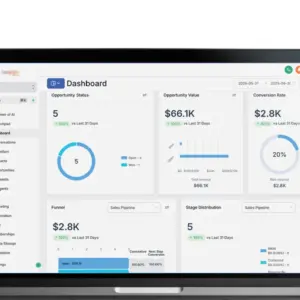How Growth-Driven Website Design Works [VIDEO]
![How Growth-Driven Website Design Works [VIDEO]](https://www.back9.co.nz/b9/wp-content/uploads/2021/01/GDD-OG-600x400.jpg)
What is growth-Driven design?
Updated 20th December 2024
In today’s fast-paced digital world, traditional website design often falls short – it’s slow, risky, and leaves little room for flexibility. So is traditional web design broken? We believe so. And that’s where Growth-Driven Design (GDD) comes in, offering a smarter, data-driven approach to building and maintaining websites that grow with your business.
So, what exactly is Growth-Driven Design? It’s a methodology that focuses on launching quickly, learning from real user behavior, and continuously improving your site to drive better results. Unlike the old “set it and forget it” approach, GDD is all about adapting to what works best for your audience.
In this article, we’ll break down how Growth-Driven Design works, guide you through its key stages, and show you why this dynamic method is reshaping the way businesses approach web design.
Ready to discover how a GDD-driven website can help you achieve your goals? Let’s dive in.
How does Growth-Driven Design work?
The Growth-Driven Design methodology has three major stages: the strategy, the launch pad, and continuous improvement.
Strategy Phase: Building the Foundation for Success
The Strategy Phase focuses on deeply understanding your audience and their needs. By stepping into their shoes, we uncover how your website can solve their problems and guide them toward their goals.
To do this, we ask key questions:
- Who are they?
- What challenges do they face?
- What are their goals?
- How does your website fit into their journey?
This phase includes several essential steps designed to ensure your website is built with a clear purpose and user-focused strategy.
![How Growth-Driven Website Design Works [VIDEO] 1 Untitled Design 15](https://www.back9.co.nz/b9/wp-content/uploads/2021/01/Untitled-design-15-760x190.png)
Steps of the strategy phase
1. Define Website Goals
We begin by reverse-engineering your business goals to determine how the website can help achieve them. The goals we define follow the SMART criteria: Specific, Measurable, Attainable, Relevant, and Timely. This ensures we can accurately track the website’s impact on your business.
2. Understand Your Audience
Through in-depth UX (User Experience) research, we uncover insights about your users. This research may include:
- Qualitative insights from interviews or surveys
- Quantitative data from analytics
- Observational studies of user behavior
The result? A clear understanding of what drives your audience and how your website can meet their needs.
3. Apply the Jobs to Be Done Framework
This framework identifies the deeper needs and motivations that drive your audience’s decisions. It helps us understand why they might choose your product or service over competitors.
Refine your audience
4. Reassess Fundamental Assumptions
We examine and refine what you already know about your market, users, and website. This includes creating or revising:
- User problem statements
- Unique value propositions
- Situational triggers
- Current user habits
- Barriers to switching
These insights form the foundation for a user-centered strategy.
5. Develop Buyer Personas
Buyer personas are detailed, fictional representations of your ideal customers. They include key attributes like:
- Challenges
- Goals
- Pain points
- Decision-making behaviors
Personas ensure your website speaks directly to your audience’s needs.
6. Map the Buyer’s Journey
We outline each persona’s journey before, during, and after interacting with your business. This map provides a clear direction for how your website can seamlessly fit into their lives, solve their problems, and guide them to take action.
Establish Website Goals and Strategy
7. Create a Website-Specific Plan
This plan includes essential elements like:
- Site architecture
- On-site SEO
- Key sections and pages
- Technical integrations and requirements
8. Build a Website Wish List
We brainstorm a list of creative, impactful ideas to solve user challenges and meet business goals. Your wish list could include 20 to 200 items, such as:
- Features and modules
- Pages and sections
- Integrations
- Interactive elements
We’ll recommend options that have been successful for businesses with similar goals.
9. Prepare for Launch
With the strategy complete, it’s time to build your Launchpad Website – a simple, high-performing site designed to go live quickly. The real magic happens in the next phase: continuous improvement.
The Launchpad Website: A Strong Start
With a carefully crafted wish list of high-impact ideas, we move into the second phase of the Growth-Driven Design methodology: building the Launchpad Website.
The goal of this phase is simple – create a site that’s not only better than what you have today but also serves as a foundation for future growth.
It’s important to note that your Launchpad Website isn’t the final version. Think of it as a starting point – a functional, high-performing site designed to go live quickly. This approach enables you to collect valuable insights by observing how real users interact with your site.
By launching quickly without sacrificing quality, you:
- Gather real-world data to make smarter, data-driven improvements.
- Achieve faster results compared to the traditional web design process, which often takes six months or more to complete.
Your Launchpad Website accelerates time-to-value, setting the stage for continuous optimisation and growth in the next phase.
![How Growth-Driven Website Design Works [VIDEO] 2 Untitled Design 16](https://www.back9.co.nz/b9/wp-content/uploads/2021/01/Untitled-design-16-760x190.png)
How to Quickly Build a Launchpad Website
Creating a high-performing Launchpad Website quickly requires strategic focus and efficient processes. Here are the key areas to prioritize to accelerate the build while maintaining quality:
1. Customise Your Approach
Every website is unique, and the approach to building a Launchpad Website should reflect that. The goal is to strike a balance between speed and quality. This often requires a mix of strategies tailored to your specific needs.
Partnering with an experienced agency (like us) can make all the difference. We guide you in selecting the best approach for your new site, ensuring a well-performing and efficient launch.
2. Leverage Design Sprints for High-Impact Pages
Design sprints are short, focused sessions that use brainstorming, prototyping, and testing to tackle specific design challenges. By concentrating on high-impact sections of your website:
- You draw on the team’s collective expertise to generate the best ideas.
- You create high-quality prototypes faster than traditional methods.
This approach ensures key pages are optimized and ready to perform from day one.
3. Streamline Content Development
Content creation – including text, images, and video – is often the most time-consuming part of any website build. To avoid delays:
- Implement an efficient content development process.
- Use collaboration tools to improve communication and productivity.
The result? Faster production timelines and higher-quality content to fuel your website’s success.
4. Invest in Internal Efficiencies
Internal efficiencies can dramatically speed up the Launchpad process. Consider these strategies:
- Transition from a waterfall process to an agile or scrum framework for faster iteration.
- Build a library of pre-designed templates to save time.
- Minimise developer dependencies, enabling marketers or in-house teams to make updates using user-friendly tools.
These optimisations empower your team to work smarter and make updates seamlessly.
Once the strategy has been created and your launchpad website is live, the next step is the Continuous Improvement stage of the Growth-Driven Design methodology.
Continuous Improvement
The Continuous Improvement stage focuses on identifying and implementing high-impact actions to grow your business using real user data. After your website is launched, it’s easy to lose focus on what will drive the most significant results. That’s why we follow a simple, agile process: Plan, Build, Learn, and Transfer.
![How Growth-Driven Website Design Works [VIDEO] 3 Untitled Design 17](https://www.back9.co.nz/b9/wp-content/uploads/2021/01/Untitled-design-17-760x190.png)
Planning: Setting the Focus
In the planning step of the cycle, we’ll define the most impactful items to build or optimize at that moment in time to drive toward your goals. This starts by determining an area of focus that your team can rally their improvement efforts around. Focus is key.
The challenge is, there are many areas you could work on: from messaging to layouts to building new pages to optimizing existing ones. The wide range of options can make it overwhelming and difficult to determine where to best focus your time.
It’s helpful to have a website performance roadmap, so we can figure out where best to focus your time, i. The performance roadmap is a framework for us ensure you’re spending time and energy on improving the most impactful areas.
The roadmap helps you set clear expectations on exactly what you should and should not be working on and why. And because there are specific metrics to measure for each focus area, you can easily measure and report on your progress building a peak-performing website.
Building
The first step in the cycle is to define the most impactful items to build or optimize to move closer to your goals. The key here is focus.
Why Focus Matters
There are countless areas you could work on—messaging, layouts, creating new pages, or optimizing existing ones. Without a clear direction, it can quickly become overwhelming to decide where to invest your time.
The Website Performance Roadmap
To stay on track, we use a performance roadmap—a framework designed to prioritize your efforts and ensure time is spent improving the areas that matter most.
- Clarity: The roadmap sets clear expectations about what to focus on and why.
- Metrics: Each focus area is tied to measurable metrics, making it easy to track progress and report results.
With the roadmap in place, your team can rally around a specific area of focus, driving meaningful improvements without distractions.
Building: Bringing the Plan to Life
The next step is implementation. Using the performance roadmap, we track progress and guide the build process across three major themes: Establish, Optimise, and Expand.
1. Establish: Laying the Foundation
The “Establish” phase focuses on foundational activities immediately after launch.
- Quick Wins: Address low-hanging fruit—high-impact actions that are fast and easy to execute.
- Audience Building: Collect data and run experiments to understand user behavior.
- Value Confirmation: Ensure the website delivers measurable value to users.
2. Optimise: Enhancing Performance
The “Optimize” phase improves both user experience and business outcomes.
- Usability Improvements: Ensure visitors can unlock value quickly and effortlessly.
- Conversion Rate Optimization (CRO): Streamline funnels to reduce friction and increase conversions.
- Personalization: Tailor experiences to individual users or segments, providing relevance and value.
3. Expand: Maximising Impact
The “Expand” phase focuses on growing the website’s role within your business.
- New Digital Products: Add features like tools, directories, or interactive resources.
- Customer Journey Enhancements: Develop elements that support the full journey, such as customer support portals or advocacy programs.
- Cross-Team Enablement: Build tools to help other teams, such as sales enablement features to assist with prospecting and closing deals.
The Expand phase helps the website contribute to the growth of the entire organisation.
The Lifecycle of Continuous Improvement
The roadmap aligns with the lifecycle of your website:
- After Launch: Focus on “Establish” and “Optimise” to stabilise and improve foundational elements.
- Over Time: Progress into the “Expand” phase to grow the website’s impact across the business.
By consistently planning, building, and optimising based on user data, your website evolves into a dynamic tool that supports long-term growth.
Is every website different?
Every website is different, which is why it’s essential to let performance metrics and user experience guide your continuous improvement efforts. By reassessing your priorities each quarter, you can focus on the areas that will deliver the greatest impact. This quarterly reassessment ensures your team directs time and resources to what matters most. Once a focus area is chosen, it’s crucial to stay consistent. Shifting focus mid-cycle can lead to wasted effort with little measurable progress.
With a clear focus, the next step is to conduct user experience research. This process uncovers the challenges or friction points users face on your website and identifies barriers that may be preventing them from reaching their goals. Armed with these insights, your team can brainstorm new action items designed to solve user challenges, deliver value, and improve key performance metrics—all while staying aligned with your chosen focus area.
After generating ideas, it’s time to prioritise. Not all ideas will have equal impact, so focus on identifying the highest-value actions first. Based on your team’s workload capacity, select the top items to implement within the quarter. Any remaining ideas can be revisited in the next planning cycle. This method ensures resources are used efficiently, delivering meaningful improvements without being stretched too thin.
By tailoring your approach to your website’s unique needs and following this structured process, you’ll create a dynamic and evolving digital experience that consistently drives results and meets user expectations.
Turning Ideas into Action
With those high-impact action items ready for the current sprint, we’ll collaboratively create detailed action item cards, each containing four essential elements:
- A clear description of the specific customer scenario, framed as a “job statement.”
- A hypothesis statement outlining your proposed change and the impact you expect it to have.
- Supporting research or data to validate your hypothesis.
- An experimental design detailing how the hypothesis will be tested.
Armed with a focus and prioritised action items, it’s time to move to the next step in the continuous improvement cycle: Build. This phase involves hosting a focused working sprint with a cross-functional team to tackle all high-impact action items.
Much like a sports team in the heat of the game, your team will “swarm” these tasks, collaborating aggressively to get them done. This means syncing schedules, aligning on meetings, and dedicating collective work time to ensure every action item is completed efficiently and effectively.
But it doesn’t stop there. Alongside building the action items, the team will set up the experiments as outlined in the experimental design. This ensures we can measure the impact of each action item accurately, validating or invalidating the original hypothesis with real data.
Once everything is ready, we’ll launch the updates and let your audience interact with the experiments. After sufficient time—specific to each experiment—we’ll move forward to the next phase in the cycle: Learn.
Learn: Turning Insights Into Growth
The Learn step is where we pause to review the experiments you’ve run and extract valuable insights about your audience. Did your original hypothesis hold true, or was it proven wrong? If it turned out wrong, that’s perfectly okay – especially when you’re starting out and testing bold new ideas.
What matters most is what you learn from the outcomes. Dive into the data and ask:
- What did your audience’s actions and behaviors reveal?
- How can these insights shape future action items?
This step is critical because every cycle adds to your understanding of your audience. The more we learn, the better we become at creating value for your users and achieving your business goals. Each iteration builds on the last, refining our approach and increasing the likelihood of success.
Learning is a cornerstone of the Growth-Driven Design philosophy. It’s an ongoing process that ensures your website continues to improve, delivering even greater results over time. With each cycle, we uncover new opportunities to optimise and grow, turning insights into actionable improvements.
Transfer: Amplifying Insights Across Your Business
The final step of the continuous improvement cycle is Transfer – where the insights gained from experiments are shared across your organisation to drive growth beyond just your website. This step ensures the knowledge and ideas generated in the cycle benefit your entire business.
Through internal communications and collaborative meetings, we’ll share findings from the experiments, showcasing what worked, what didn’t, and the reasons behind each outcome. These insights fuel strategic recommendations for future improvements while opening up discussions with other teams to uncover additional opportunities and fill gaps in user research. This collaborative approach turns website learnings into company-wide advancements.
The transfer phase also reinforces the cyclical nature of Growth-Driven Design. Every two weeks, the steps – plan, build, learn, and transfer – are repeated, creating momentum with each iteration. New action items are implemented to achieve the current quarterly focus, and once metric goals are met, attention shifts to a new theme from your website performance roadmap. This ensures your website and business continue to grow and adapt, delivering greater value to users and sustained success over time.
Growth-Driven Design: A Smarter Path to Website Success
The Growth-Driven Design methodology begins with careful planning and research during the Strategy Phase, where we develop a deep understanding of your audience and create a solid roadmap for success. Next comes building a comprehensive wish list of ideas that guide the creation of your Launchpad Website—a high-performing foundation that’s better than what you have today but designed to grow and evolve over time.
From there, the focus shifts to the Continuous Improvement Phase, where we implement a cycle of plan, build, learn, and transfer to drive month-over-month improvements. This ongoing process ensures your website continues to meet user needs, improve performance metrics, and adapt to emerging trends.
Unlike traditional “set-it-and-forget-it” web design, Growth-Driven Design offers a dynamic, iterative approach that keeps your website ahead of the curve in an ever-evolving digital landscape.
The future of web design is Growth-Driven
A Growth-Driven Website Design doesn’t just adapt; it evolves. By continuously improving, it drives results month after month, helping every aspect of your business grow.
Think of Growth-Driven Design as the foundation of a high-performance sports car. While the design itself is sleek and powerful, you still need fuel—your marketing and sales efforts—to keep it moving. Together, these elements create the ultimate engine for business growth.
The challenges of traditional, “set-it-and-forget-it” web design are solved with Growth-Driven Design. This is the future of web design—the playbook for building a peak-performing website that grows with your business.
If you’re inspired to leave behind outdated web design and start building a website that drives real growth, let’s talk! Hit the meeting button below to explore how Growth-Driven Website Design can work for your business.
All information about the growth-driven website design methodology is derived from Hubspot and Growth-Driven Design.





